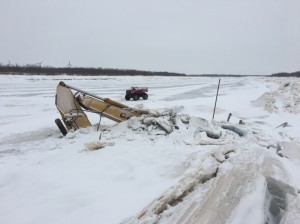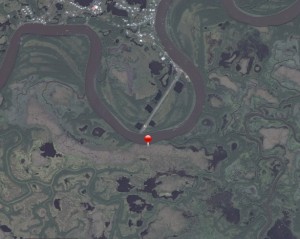
The United States Coast Guard and the Alaska Department of Environmental Conservation are coordinating initial cleanup efforts with the city of Tuntutuliak in Southwest Alaska. USCG sent responders to the scene where a Caterpillar EL180 excavator fell through the ice on the Qinaq River near the small community to assess the site late last month.
The excavator, owned by Wilson’s General Contracting and Specialties Supply, fell through the ice on the evening of March 24 when it was being moved from that community to Kongiganak.
Citing safety considerations and current conditions on the river, the actual removal of the semi submerged heavy equipment will not be initiated until the River ice breakup is complete and a barge can safely navigate the river to remove it. The location where it went through the ice in the river approximately 15 feet from the south shore four miles upstream from the Kuskokwim River.

“Cleanup efforts are ongoing and we hope to mitigate the effects of the spill and remove the excavator as soon as safely possible,” said Lt. Todd Bagetis, Sector Anchorage response. “Sector Anchorage will continue to work closely alongside the Unified Command and federal and state partners to monitor the situation and address local concerns.”
The USCG Unified Command is continuing to assess any risk to the community’s drinking water supply and the subsistence fisheries in the area. DEC is advising community residents to use the public water system rather than using their traditional source of water from the river has the public water system is monitored regularly for contaminants.
“If people do choose to use their traditional sources, they should collect water from upstream of the excavator,” said Christian. “All water from the river that is used for drinking, cooking and brushing teeth should be boiled for 2 minutes before use.”
[xyz-ihs snippet=”adsense-body-ad”]Signs have been placed in the community warning of the contaminants and a Wilson company employee is monitoring the location daily.
The excavator was reported to have, at most, 40 gallons of diesel oil, 40 gallons of hydraulic fluid, and 5 gallons of lubricating oil on board. It is unknown at this time how much of those petroleum products were discharged when the excavator went through the ice. But, Jeanette Alas, with the Alaska Department of Fish and Game stated that they are actively engaged in the response. The department says that they expect only minimal impacts to fish and their habitat in the incident.
“ADF&G will work within the Incident Management Team to issue a Title 16 Fish Habitat Permit to the owner to remove the bulldozer in a manner that minimizes impacts to fish and their habitat,” said Alas.
